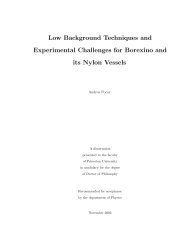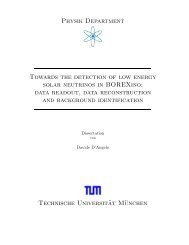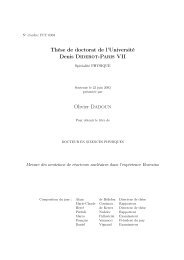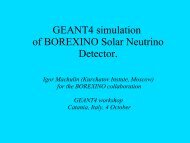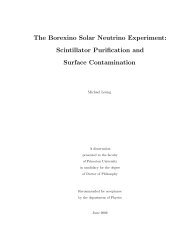Development of a Liquid Scintillator and of Data ... - Borexino - Infn
Development of a Liquid Scintillator and of Data ... - Borexino - Infn
Development of a Liquid Scintillator and of Data ... - Borexino - Infn
You also want an ePaper? Increase the reach of your titles
YUMPU automatically turns print PDFs into web optimized ePapers that Google loves.
7.4 Analysis <strong>of</strong> the Source Runs<br />
short period <strong>of</strong> time. The event registered by the detector consists <strong>of</strong> an overlap <strong>of</strong> these single<br />
interactions. The effective position <strong>of</strong> such an event is the ‘center <strong>of</strong> light’ <strong>of</strong> the various<br />
energy deposits. A gamma event is hence called an ‘extended event’. The higher the energy <strong>of</strong><br />
the gamma, the larger the extension <strong>of</strong> the event. The Monte Carlo for the CTF gives for the<br />
energy dependence <strong>of</strong> the spatial resolution a rather flat curve, after an initial decrease at low<br />
energies.<br />
The Bi-decay consists <strong>of</strong> a beta decay to an excited state <strong>of</strong> Po, followed by the emission<br />
<strong>of</strong> one or more -rays. The energy dependence <strong>of</strong> the position resolution for these events is<br />
shown in fig. 7.7 <strong>and</strong> compared to the Monte Carlo resolutions for beta <strong>and</strong> gamma events. The<br />
resolution as measured in the CTF2 is worse than predicted by the Monte Carlo, indicating<br />
that some effects on the timing are not fully accounted for in the Monte Carlo.<br />
7.4.4 Energy Resolution<br />
Ideally, the relative energy resolution should be directly proportional to Ô ÒÔ, where ÒÔ is<br />
the number <strong>of</strong> photoelectrons. The Po alpha events correspond to 950 keV beta equivalent<br />
energy, if the scintillator is not quenched. The measured pulse height during the runs 758 -<br />
789 is ( ¦ ) photoelectrons (see fig. 7.8). This gives a relative energy resolution <strong>of</strong><br />
¡<br />
Ô ÒÔ<br />
For source no. 1 the measured pulse height is ( ¦ ) photoelectrons, leading to<br />
¡<br />
Ô ÒÔ<br />
For source no. 2 the measured pulse height is ( ¦ ) photoelectrons, giving<br />
¡<br />
<br />
<br />
Ô ÒÔ<br />
<br />
<br />
<br />
109



